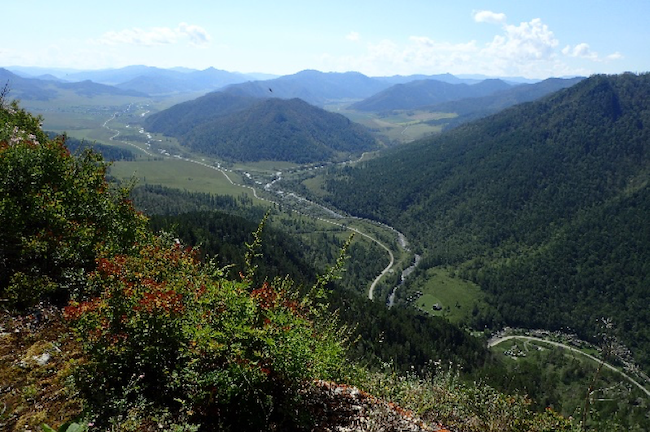 Evolution & Behaviour
Evolution & Behaviour
A timeline for the Denisovans, an enigmatic group of archaic humans
The Denisovans are a mysterious group of archaic humans named after the type locality of Denisova Cave in southern Siberia. The site was also occupied at times by Neanderthals and modern humans. Thanks to optical dating and environmental reconstructions we defined a robust chronology for these archaic humans.

One of the most intriguing revelations in human evolution of the past decade was the announcement in 2010 of the genome of a completely unknown archaic human (hominin), obtained from a girl's fingerbone found buried in Denisova Cave - a three-chambered cavern nestled in the foothills of the Altai Mountains in southern Siberia. Even more astonishingly, present-day Aboriginal Australian and New Guinean people have by far the greatest amount of Denisovan DNA in their genomes, despite living 8,000 km away.
Denisova Cave not only contains the fossil and genetic remains of this enigmatic group - dubbed the Denisovans - but was also home at various times to Neanderthals, a sister group to the Denisovans, as well as modern humans (Homo sapiens). Placing these comings and goings on a reliable timeline has proven elusive, however, largely because the deposits containing traces of Denisovans and Neanderthals are too old for radiocarbon dating, which is limited to the last 50,000 years.
In our recent paper, we used another method - known as optical dating - that can extend back much further to establish when the sediments were deposited in the cave, along with the hominin fossils, a trove of artefacts, and a range of animal and plant remains. Optical dating gives an estimate of the time since grains of ubiquitous minerals such as quartz and feldspar were last exposed to sunlight. We measured more than 280,000 individual grains of these minerals to date the deposits in all three chambers of the cave, and the accompanying clues to the life and times of the Denisovans and Neanderthals.
Just eight fossils have been identified as Denisovan or Neanderthal in the 40 years since the cave was first excavated: the girl's fingerbone and three teeth of Denisovans, three bone fragments of Neanderthals, and a bone fragment from the daughter of Neanderthal and Denisovan parents. However, the cave sediments also contain traces of Denisovan and Neanderthal DNA, as well as thousands of stone tools, artefacts made from other materials in the upper layers, and abundant remains of fauna and flora that reveal the environmental conditions in the vicinity of the cave.
Our study represents the culmination of seven years of collaboration with our Russian colleagues, who have assembled detailed records of the archaeology of archaic and modern humans at the site and of the animals and plants that lived in and around the cave. Our chronology also underpins a second study, led by colleagues in Germany and England, that weaves together all of the strands of dating evidence - including the genetic data from the hominin fossils - to obtain improved age constraints for the fragmentary remains, which could easily have been displaced after deposition.
From the artefacts deposited in the cave, we now know that hominins were present as early as 300,000 years ago, but we cannot say who made these stone tools, because no hominin fossils or DNA have been retrieved from these oldest deposits. The earliest fossil or genetic traces of Denisovans appear 200,000 years ago, and the latest as recently as 50,000 years ago. Fossils and DNA of Neanderthals were recovered from sediment layers that accumulated between 190,000 and 90,000 years ago, so both groups of archaic hominins lived through the cold and warm fluctuations in climate that occurred during this period.
Given these new insights, what are the key issues that remain unresolved? For starters, we cannot be certain who made the bone points, tooth pendants and other personal ornaments found in the upper layers, because no fossils or DNA of modern humans have yet been obtained from these deposits. Our Russian colleagues consider these artefacts to be the handiwork of Denisovans. Ongoing excavations may shed light on this mystery, and the nature of any encounters between Denisovans and modern humans.
We also now know that the latest Denisovans could conceivably have encountered modern humans dispersing through Asia before 50,000 years ago. At present, however, we can only speculate on the geographical distribution of Denisovans and whether their DNA entered the modern human genome in the Altai region or elsewhere. To solve that riddle requires more discoveries at other sites in northern Asia, other parts of Asia and further afield.
Original Article:
Z. Jacobs et al., Timing of archaic hominin occupation of Denisova Cave in southern Siberia. Nature 565, 594-599 (2019)Edited by:
Massimo Caine , Founder and Director
We thought you might like
An ancient affair: a Neandertal woman and a Denisovan man had a daughter
Jun 19, 2019 in Evolution & Behaviour | 4 min read by Viviane SlonMore from Evolution & Behaviour
Cicada emergence alters forest food webs
Jan 31, 2025 in Evolution & Behaviour | 3.5 min read by Martha Weiss , John LillSize does not matter: direct estimations of mutation rates in baleen whales
Jan 29, 2025 in Evolution & Behaviour | 4 min read by Marcos Suárez-MenéndezThe Claws and the Spear: New Evidence of Neanderthal-Cave Lion Interactions
Jan 22, 2025 in Evolution & Behaviour | 3.5 min read by Gabriele RussoA deep-sea spa: the key to the pearl octopus’ success
Jan 20, 2025 in Evolution & Behaviour | 3.5 min read by Jim BarryFeisty fish and birds with attitude: Why does evolution not lead to identical individuals?
Aug 31, 2024 in Evolution & Behaviour | 3 min read by Lukas Eigentler , Klaus Reinhold , David KikuchiEditor's picks
Trending now
Popular topics


